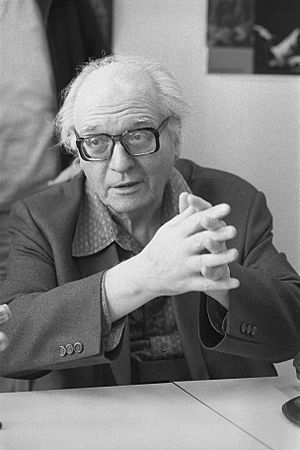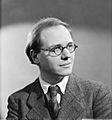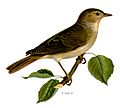Olivier Messiaen facts for kids
Olivier Messiaen (born in Avignon, France, on December 10, 1908; died near Paris on April 27, 1992) was a famous French composer and organist. He is known as one of the most important and original composers of the mid-20th century. Messiaen was an amazing organist. He played the organ at the church of La Trinité in Paris for over 60 years!
He wrote music for orchestra, piano, and organ. Many of his pieces are quite challenging to play. Messiaen was also a great music teacher. He taught many students who later became famous composers themselves. Some of his well-known students include Pierre Boulez and Karlheinz Stockhausen. His second wife, Yvonne Loriod, was also one of his students.
Contents
Biography
Early Life and Musical Journey
Messiaen started composing music when he was just seven years old. When he saw the score for Debussy’s opera Pelléas et Mélisande, he could hear the music in his mind. This made him realize he wanted to be a composer. He began studying at the Paris Conservatoire when he was 11 years old. His teachers included famous composers like Paul Dukas and Marcel Dupré. In 1930, he became the organist at the church of La Trinité in Paris. He held this job for the rest of his life.
World War II and Famous Compositions
When World War II started in 1940, Messiaen became a prisoner of war. While he was held in a camp, he composed a very famous piece of chamber music. It was called Quatour pour la fin du temps ("Quartet for the End of Time"). He wrote it for piano, violin, cello, and clarinet. These were the only instruments available in the camp. The piece was first performed for 5,000 prisoners and guards.
After he was freed in 1941, Messiaen became a professor of harmony at the Paris Conservatoire. He composed 20 pieces for piano called Vingt regards sur l’enfant Jésus (Twenty Visions of the Child Jesus). He also wrote a book about his way of composing music. It was called Technique de mon langage musical (The Technique of my Musical Language).
Global Teaching and Birdsong Inspiration
Messiaen soon became famous for his teaching. He was invited to teach in other countries, including Germany, Hungary, and the United States. He became very interested in the rhythms of Greek and Hindu music.
After his first wife died in 1959, he remarried in 1961. He also became very interested in birdsong. He spent a lot of time with his wife in the countryside. They used a tape recorder to record bird songs. He then used these bird songs in his music. Some of his piano pieces, like Oiseaux exotiques (Exotic Birds) and Catalogue d’oiseaux (Catalogue of Birds), are full of bird sounds.
Major Works and Later Life
Messiaen wrote a lot of organ music that he performed himself. A popular piece is Transports de joie (Outburst of Joy). It is part of a larger work called L'Ascension (The Ascension). Another long organ work is La Nativité du Seigneur (The Birth of our Lord). The last part of this piece, Dieu parmi nous (God Among Us), is often played by organists at recitals or after Christmas carol services.
He also wrote a long orchestral piece called the Turangalîla Symphony. It was first performed in Boston in 1949. The French government asked him to compose Et exspecto resurrectionem mortuorum (And We Expect the Rising of the Dead). This piece honored those who died in the two world wars. It was performed in Chartres Cathedral in 1965. In 1966, Messiaen became a professor of composition at the Paris Conservatoire.
A visit to the Grand Canyon inspired him to write a ten-part orchestral piece. It was called Des Canyons aux étoiles (From the Canyons to the Stars). It was first performed in New York in 1974.
In 1971, Messiaen was asked to write an opera for the Paris Opéra. He finally agreed in 1975 and started working on his opera Saint-François d'Assise. It took him several years to finish. It was performed in 1983. Messiaen preferred to call it a "spectacle" rather than an "opera."
Messiaen retired from teaching in 1978. In 1987, he received the highest French honor, the Grand-Croix of the Légion d'honneur. He passed away in 1992, after finishing his last piece, Éclairs sur l'au delà.
Music style
Unique Rhythms and Harmonies
Messiaen described himself as a "composer and rhythmician." This means that rhythm was super important in his music. He studied ancient Greek and Hindu rhythms. He liked using rhythms with odd numbers. For example, a bar of his music might have 17 short notes instead of a more common even number. He was also very influenced by the rhythms in Stravinsky’s famous piece The Rite of Spring.
Messiaen’s harmonies sound very unique. He loved scales that could only be moved in two or three different ways. He called these "modes of limited transposition."
Sounds, Colors, and Instruments
Messiaen’s music is full of different sounds. He wrote very well for large orchestras and the organ. He used different instruments and organ sounds in new ways. For example, in Chronochromie (1960), he used a large orchestra. Messiaen had synesthesia. This meant that music often made him think of particular colours.
In his orchestra, Messiaen often used an instrument called the ondes Martenot. This was an early electronic keyboard instrument. His sister-in-law, Jeanne Loriod, was a famous player of this instrument. Messiaen was also influenced by Indonesian gamelan music.
Messiaen was a very religious Roman Catholic his whole life. His faith was a huge influence on his life and music.
Images for kids
-
The garden warbler provided the title and much of the material for Messiaen's La fauvette des jardins.
See also
 In Spanish: Olivier Messiaen para niños
In Spanish: Olivier Messiaen para niños









